Structural mechanism for the selective phosphorylation of DNA-loaded MCM double hexamers by the Dbf4-dependent kinase
- PMID: 34963704
- PMCID: PMC8770131
- DOI: 10.1038/s41594-021-00698-z
Structural mechanism for the selective phosphorylation of DNA-loaded MCM double hexamers by the Dbf4-dependent kinase
Abstract
Loading of the eukaryotic replicative helicase onto replication origins involves two MCM hexamers forming a double hexamer (DH) around duplex DNA. During S phase, helicase activation requires MCM phosphorylation by Dbf4-dependent kinase (DDK), comprising Cdc7 and Dbf4. DDK selectively phosphorylates loaded DHs, but how such fidelity is achieved is unknown. Here, we determine the cryogenic electron microscopy structure of Saccharomyces cerevisiae DDK in the act of phosphorylating a DH. DDK docks onto one MCM ring and phosphorylates the opposed ring. Truncation of the Dbf4 docking domain abrogates DH phosphorylation, yet Cdc7 kinase activity is unaffected. Late origin firing is blocked in response to DNA damage via Dbf4 phosphorylation by the Rad53 checkpoint kinase. DDK phosphorylation by Rad53 impairs DH phosphorylation by blockage of DDK binding to DHs, and also interferes with the Cdc7 active site. Our results explain the structural basis and regulation of the selective phosphorylation of DNA-loaded MCM DHs, which supports bidirectional replication.
© 2021. The Author(s).
Conflict of interest statement
The authors declare no competing interests.
Figures





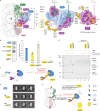
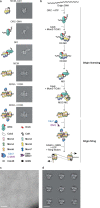
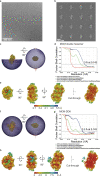
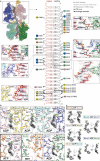
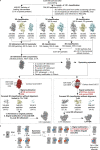
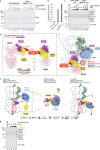
Similar articles
-
Dbf4 and Cdc7 proteins promote DNA replication through interactions with distinct Mcm2-7 protein subunits.J Biol Chem. 2013 May 24;288(21):14926-35. doi: 10.1074/jbc.M112.392910. Epub 2013 Apr 2. J Biol Chem. 2013. PMID: 23549044 Free PMC article.
-
Domain within the helicase subunit Mcm4 integrates multiple kinase signals to control DNA replication initiation and fork progression.Proc Natl Acad Sci U S A. 2014 May 6;111(18):E1899-908. doi: 10.1073/pnas.1404063111. Epub 2014 Apr 16. Proc Natl Acad Sci U S A. 2014. PMID: 24740181 Free PMC article.
-
Structural Insight into the MCM double hexamer activation by Dbf4-Cdc7 kinase.Nat Commun. 2022 Mar 16;13(1):1396. doi: 10.1038/s41467-022-29070-5. Nat Commun. 2022. PMID: 35296675 Free PMC article.
-
DDK promotes DNA replication initiation: Mechanistic and structural insights.Curr Opin Struct Biol. 2023 Feb;78:102504. doi: 10.1016/j.sbi.2022.102504. Epub 2022 Dec 14. Curr Opin Struct Biol. 2023. PMID: 36525878 Review.
-
Dbf4-Dependent Kinase: DDK-ated to post-initiation events in DNA replication.Cell Cycle. 2021 Nov;20(22):2348-2360. doi: 10.1080/15384101.2021.1986999. Epub 2021 Oct 18. Cell Cycle. 2021. PMID: 34662256 Free PMC article. Review.
Cited by
-
Unidirectional MCM translocation away from ORC drives origin licensing.Nat Commun. 2025 Jan 17;16(1):782. doi: 10.1038/s41467-025-56143-y. Nat Commun. 2025. PMID: 39824870 Free PMC article.
-
The structural mechanism of dimeric DONSON in replicative helicase activation.Mol Cell. 2023 Nov 16;83(22):4017-4031.e9. doi: 10.1016/j.molcel.2023.09.029. Epub 2023 Oct 10. Mol Cell. 2023. PMID: 37820732 Free PMC article.
-
A conserved phosphorylation mechanism for regulating the interaction between the CMG replicative helicase and its forked DNA substrate.J Biol Chem. 2025 Apr;301(4):108408. doi: 10.1016/j.jbc.2025.108408. Epub 2025 Mar 14. J Biol Chem. 2025. PMID: 40090586 Free PMC article.
-
Structural dynamics of DNA unwinding by a replicative helicase.Nature. 2025 May;641(8061):240-249. doi: 10.1038/s41586-025-08766-w. Epub 2025 Mar 19. Nature. 2025. PMID: 40108462 Free PMC article.
-
DBF4, not DRF1, is the crucial regulator of CDC7 kinase at replication forks.J Cell Biol. 2024 Aug 5;223(8):e202402144. doi: 10.1083/jcb.202402144. Epub 2024 Jun 12. J Cell Biol. 2024. PMID: 38865090 Free PMC article.
References
Publication types
MeSH terms
Substances
Grants and funding
LinkOut - more resources
Full Text Sources
Molecular Biology Databases

